Content
- 1 The composition and benefits of potato peelings in the garden
- 2 Benefits of using potato peelings in the garden
- 3 Ways to use potato peelings for the garden
- 4 When and how to use potato peels as fertilizer
- 5 What plants can not be fed with potato peelings
- 6 Rules for the use of potato peelings in the garden or in the garden
- 7 Conclusion
Every gardener understands that for bountiful harvests, plants need periodic feeding. Potato peelings as fertilizer are not only an effective additive, but also an environmentally friendly component. Their periodic application improves the growth of both garden and indoor plants.
The composition and benefits of potato peelings in the garden
Natural fertilizers that you can make with your own hands have always been appreciated among summer residents. Potato peelings are good for plants, so they have been used for centuries to improve soil fertility and increase the yield of many crops.
Among the advantages are:
- harmless to plants;
- the ability to secure planting from sudden frosts;
- strengthening of the root system;
- improving seed germination and accelerating the growing season of adult plants.
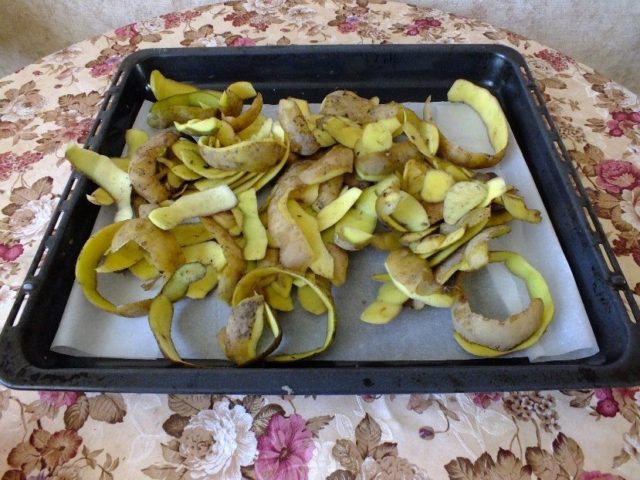
Potato peel - a source of valuable vitamins and nutrients
for garden and vegetable garden
Excellent agrotechnical indicators of fertilization in potato peelings are provided due to the rich vitamin and mineral composition of the feedstock. The peel contains a large amount of starch, organic acids, micro and macroelements - sodium, potassium, phosphorus and calcium. In addition, it is rich in vitamin C, fat and glucose.
Benefits of using potato peelings in the garden
A feature of using potato peel-based fertilizer in the garden and in the garden is its minimum price. Cleaners are most often just thrown into the trash can, but when properly prepared, they can compete with mineral and organic fertilizers.
The most important benefits are as follows:
- the ability to increase the level of humus in the soil;
- improvement of soil aeration;
- 100% digestibility in soil;
- limiting the growth of weeds;
- help in the fight against garden pests.
Potato peel is an environmentally friendly material. Regardless of the error in dosage, they will not harm the soil and will not cause the death of plants. The prepared fertilizer will also not harm people and animals.
Ways to use potato peelings for the garden
With the right preparation of natural fertilizers, their use can bring unprecedented yields. Since the introduction of bait based on potato peelings is most often carried out in the spring, raw materials for it must be started to harvest in the fall. Since the volume of the final product will be significantly less than the prepared mass, it is worth trying to collect enough cleanings.
There are several ways to make fertilizers from raw materials. You must follow the simple rules for making groundbait. Potato peelings should not be collected from rotten root crops - the fermentation process must be strictly controlled.
Drying
The easiest way to preserve cleaning is to dry it. The collected raw materials are thoroughly washed with running water and laid out on the windowsill on the sunny side of the house. They are periodically turned over to avoid debate. Already after 10-12 days, the material will be ready for use or further storage.
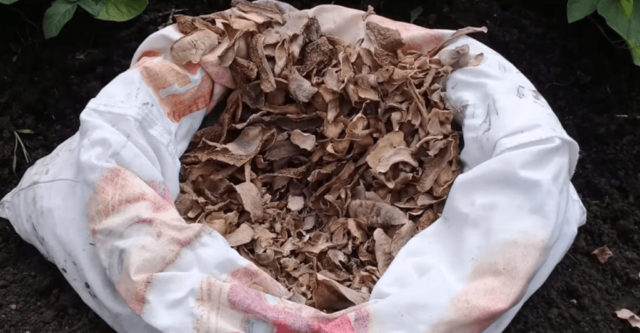
Drying is the easiest way to prepare fertilizer from cleanings
Modern kitchen devices make the life of gardeners much easier. The use of a convection oven allows you to prepare fertilizer in 3-4 hours. Thoroughly washed cleanings are placed in an oven at a temperature of 80-90 degrees. For better air circulation, it is recommended to leave the door slightly open.
Freezing
To prepare fertilizer in the freezer, only fresh cleanings are suitable. The use of previously frozen or boiled raw materials minimizes the nutritional properties of the finished bait, since heat treatment destroys vitamin and mineral reserves.
The potato peel is washed to remove dirt and dried to remove excess moisture. Then it is folded into plastic bags and frozen in a refrigerator. Considering the large volume of workpieces, it is recommended to purchase a separate device. In cold winters, you can store the peel on an unheated balcony.
Gruel
Fertilizer preparation according to this principle involves short-term infusion of the peel in water and further processing of raw materials into a homogeneous mass. Potato peelings are washed with water, then scalded with boiling water to remove possible harmful organisms. They are then dried and stacked tightly in large glass jars or food grade plastic buckets.
The cleanings are poured with warm water, covered with gauze and left for 7-10 days. As soon as they swell, grind them in any convenient way. The resulting gruel is immediately used for its intended purpose or stored in a cool place for up to several months.
Infusion
Unlike the rather long preparation time for the gruel, the infusion of potato peelings will be ready for use the very next day after brewing. The washed peel is folded into a glass jar and poured with boiling water in a 1: 1 ratio. This fertilizer can be used not only for garden plants, but also for home plantings and seedlings.
Composting
The use of potato peelings to make organic compost has been practiced for generations. It has been scientifically proven that the skins speed up fermentation by generating a lot of heat. The overheating of compost when using cleaners is accelerated almost twice.
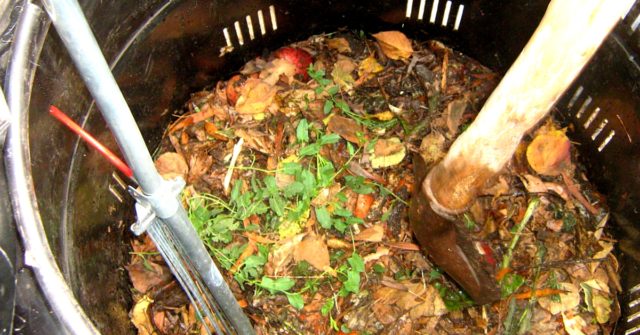
Potato peel significantly speeds up the composting process
In the case of potatoes, it is best to use monoculture compost. In this case, the cleanings will ferment evenly, decay and fungal damage are excluded. To completely protect the garden from various diseases, you can use already boiled cleanings for fertilization.
Potato flour
Making loose bait from potato peelings is an excellent solution for all gardeners. This fertilizer is distinguished by its versatility in application, as well as ease of storage. Completely devoid of moisture, it can be easily stored for up to several years, while retaining its nutritional properties.
Potato peelings are dried to complete dehydration in an electric dryer or oven. Then the raw materials are ground in a blender or coffee grinder to a fine powder. The finished fertilizer is poured into cellophane bags and stored until later use.
When and how to use potato peels as fertilizer
Even having made a high-quality top dressing, you may not get the desired results if you do not follow the simple rules of agricultural technology. While excess fertilization will not cause serious injury to the plants, it will not promote increased vegetation. At the same time, insufficient application of nutrients can completely worsen the final yield.
It is important to remember that, depending on the method of application of potato peelings, not only the proportions and doses of fertilizer, but also the recommended application period, can completely change. The use of potato peel as a fertilizer for a vegetable garden or fertilizing for fruit and berry crops is significantly different from a set of measures for caring for flowers or home plants.
How to use potato peels in the garden
The most popular way to use fertilizer is to increase the yield of garden crops. When applying the correct doses of bait, experienced summer residents achieve accelerated germination and vigorous growth.
Potato peels work best with the following crops:
- watermelons and melons;
- cucumbers and zucchini;
- cabbage;
- bow;
- turnip;
- garlic.
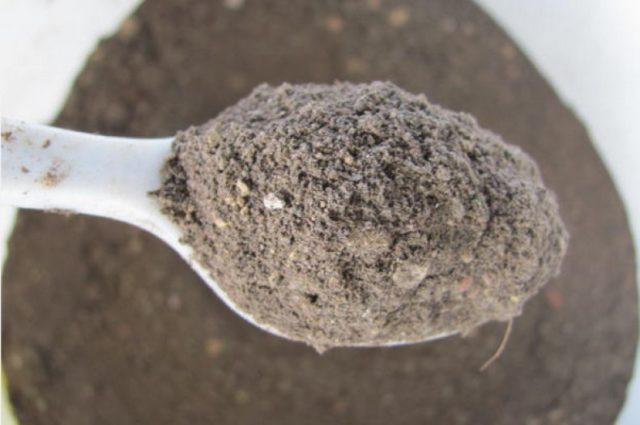
Dry fertilizer from purification - a real complex of mineral and organic substances
Separate dosages are prescribed for each crop plant. In addition, in many cases it is recommended to use fertilizer prepared by different methods - in some cases compost is better, in others - a decoction or gruel.
For plants of the pumpkin family
Most melons and gourds love potato skin fertilization. Peeling works best with cucumbers, increasing their yield by 40-50%. In addition, peel flour is ideal as a complex groundbait for watermelon, melon or zucchini.
Dry fertilizer is applied at the time of planting seedlings in open ground or greenhouse at the rate of 500 g per 10 liters of water. In the future, it is recommended to process crops with potato infusion. They are sprayed with bushes once a week until the first ovaries form.
For cabbage
Potato peelings are ideal as a starter fertilizer when planting crops outdoors. When feeding cabbage seedlings, it improves survival rate, and also accelerates the formation of the root system. For fertilization, gruel prepared from dried raw materials immediately before planting is best suited.
The prepared mass is divided into small lumps. Each of them is laid out on the bottom of the planting holes. A seedling is placed on top and rooted, sprinkled with a layer of earth. As an additional bait, you can apply periodic spraying with infusion or the introduction of a small amount of dry flour from the rind.
For onions and root vegetables
Most crucifers in the garden will respond to potato-based fertilization with great returns. It works best for onions, garlic and radishes. It was also noted that the productivity of other root crops - turnips and radishes, also significantly increases with proper complementary feeding.

For onions, an infusion cooked on potato skins is best.
Cruciferous root vegetables prefer infusion on potato skins. The first spraying of seedlings is carried out no earlier than May 20 at a frequency of two weeks. Fertilization is carried out until the crops are fully ripe.
For feeding seedlings
Young immature plants are very demanding on the soil. Even in rich soils, the survival rate of seedlings may leave much to be desired, therefore experienced gardeners recommend adding a root activator to the planting holes without fail - gruel from peelings or an infusion on them. A small amount of top dressing is added to each hole, after which the seedlings are planted directly.
How to use for fertilizing fruit and berry crops
Potato peel is a truly versatile tool for gardeners and gardeners. It can be used not only for planting cabbage, onions and garlic, but also to improve the yield of fruit and berry crops, such as:
- raspberries;
- Strawberry;
- gooseberry;
- currant.
A well-chosen feeding strategy for berry bushes and small fruit trees will allow you to get bountiful harvests even in the worst weather conditions. The vitamin and mineral complex contained in potato peelings is a powerful stimulant for most berry plantings.
For gooseberries and currants
The best way to improve the fruiting of berry bushes is gruel made from dried or fresh peels. Fertilization is carried out after the appearance of the first fruit ovaries at the rate of up to 500 g of the finished mixture for each bush. The result of this bait is a significant increase in the size of the harvested berries.
For raspberries and strawberries
For raspberries, an infusion on potato skins is better. The plantings are treated with it every 2 weeks after the appearance of the first fruit ovaries. Immediately after the snow melts, you can feed the raspberry bushes with infusion to activate the roots.
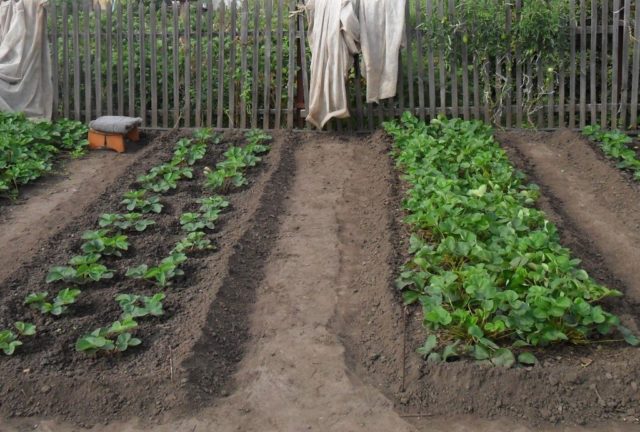
Strawberry beds are treated with dry fertilizer obtained from potato peelings
Strawberries are more finicky in terms of agricultural technology. Experienced gardeners do not recommend the treatment of immature bushes with strong infusions and gruel. Strawberry beds are treated with dry potato fertilizer twice a season - after the snow melts and after the first whiskers appear.
Flower feeding with potato peelings
The most common way to use potato skins as fertilizer for flower plantings is by watering pots and flower beds with a decoction of unpeeled potatoes. The peel will completely give the nutrients to the water. It must be cooled to room temperature and then used for watering flowers.
In the case of growing saprophytic crops such as orchids or dracaena, covering the substrate with a layer of potato peels can be used. With this approach, it is important to take care of reliable drainage - ordinary sawdust is best suited.
Feeding indoor plants with potato peelings
Home flower gardens and green succulents also need periodic feeding, rich in vitamins and minerals. Lack of nutrients makes them look faded and is also one of the most common causes of wilting. The use of potato peelings as a fertilizer allows you to restore their bright appearance, as well as strengthen the immune system and restore vegetative processes.
Potato peel infusion is most often used for indoor plants. Plants are watered with it in small quantities. It is important to observe the frequency of watering within 1 time in 1.5-2 months.
What plants can not be fed with potato peelings
Despite the completely organic origin of bait, there are several significant restrictions on its use. Most often, such measures are associated with the fact that the feedstock is close in nature to other crops in the garden. For example, if potatoes have been infected with fungal diseases and the cleanings have not been disinfected, fertilization can seriously damage future Solanaceous plantings.

It is not recommended to use potato peels as fertilizer for nightshade crops
The most at risk are crops that are biologically related to potatoes. These include tomatoes, bell peppers, and eggplants. Diseases can damage both future roots and the green part of plants.
Rules for the use of potato peelings in the garden or in the garden
Despite the ease of use of this natural fertilizer, there are several simple recommendations and restrictions that can significantly improve yields and protect plantings from possible diseases. Many inexperienced summer residents simply throw cleaning on the beds - this approach can cause not only the appearance of rodents in the backyard, but also provoke the onset of a serious illness. When a large amount of heat is released from a rotting peel, the stems and leaves of plantings can be damaged by rot or fungal diseases.
It is also important to remember about the frequency of baits. You should not apply fertilizer in the form of an infusion more than once every 2 weeks. The gruel can be used once every 1-2 months. Dry fertilizer from cleanings is used no more than 2 times per season.
Conclusion
Potato peelings as fertilizer have long been used by many summer residents and gardeners. They are used to improve the fruiting of many crops, as well as to accelerate vegetative functions. The high content of minerals and ease of use makes this product very popular on many personal subsidiary plots.








